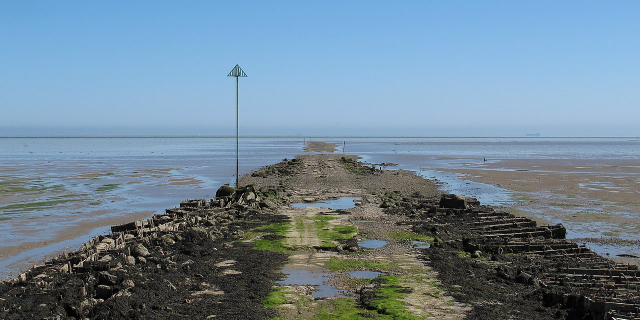Channel Tunnel
The Channel Tunnel (French: Tunnel sous la Manche), sometimes referred to informally as the Chunnel, is a 50.46-kilometre (31.35 mi) undersea railway tunnel, opened in 1994, that connects Folkestone (Kent, England) with Coquelles (Pas-de-Calais, France) beneath the English Channel at the Strait of Dover. It is the only fixed link between the island of Great Britain and the European mainland. At its lowest point, it is 75 metres (246 ft) below the sea bed and 115 metres (377 ft) below sea level. At 37.9 kilometres (23.5 mi), it has the longest underwater section of any tunnel in the world and is the third-longest railway tunnel in the world. The speed limit for trains through the tunnel is 160 kilometres per hour (99 mph). The tunnel is owned and operated by Getlink, formerly Groupe Eurotunnel.
The tunnel carries high-speed Eurostar passenger trains, LeShuttle services for road vehicles and freight trains. It connec...Read more
The Channel Tunnel (French: Tunnel sous la Manche), sometimes referred to informally as the Chunnel, is a 50.46-kilometre (31.35 mi) undersea railway tunnel, opened in 1994, that connects Folkestone (Kent, England) with Coquelles (Pas-de-Calais, France) beneath the English Channel at the Strait of Dover. It is the only fixed link between the island of Great Britain and the European mainland. At its lowest point, it is 75 metres (246 ft) below the sea bed and 115 metres (377 ft) below sea level. At 37.9 kilometres (23.5 mi), it has the longest underwater section of any tunnel in the world and is the third-longest railway tunnel in the world. The speed limit for trains through the tunnel is 160 kilometres per hour (99 mph). The tunnel is owned and operated by Getlink, formerly Groupe Eurotunnel.
The tunnel carries high-speed Eurostar passenger trains, LeShuttle services for road vehicles and freight trains. It connects end-to-end with high-speed railway lines: the LGV Nord in France and High Speed 1 in England. In 2017, rail services carried 10.3 million passengers and 1.22 million tonnes of freight, and the Shuttle carried 10.4 million passengers, 2.6 million cars, 51,000 coaches, and 1.6 million lorries (equivalent to 21.3 million tonnes of freight), compared with 11.7 million passengers, 2.6 million lorries and 2.2 million cars by sea through the Port of Dover.
Plans to build a cross-Channel tunnel were proposed as early as 1802, but British political and media criticism motivated by fears of compromising national security had disrupted attempts to build one. An early unsuccessful attempt was made in the late 19th century, on the English side, "in the hope of forcing the hand of the English Government". The eventual successful project, organised by Eurotunnel, began construction in 1988 and opened in 1994. Estimated to cost £5.5 billion in 1985, it was at the time the most expensive construction project ever proposed. The cost finally amounted to £9 billion (equivalent to £19 billion in 2021), well over budget.
Since its opening, the tunnel has experienced occasional mechanical problems. Both fires and cold weather have temporarily disrupted its operation. Since at least 1997, aggregations of migrants around Calais seeking entry to the United Kingdom, such as through the tunnel, have prompted deterrence and countermeasures.































Add new comment